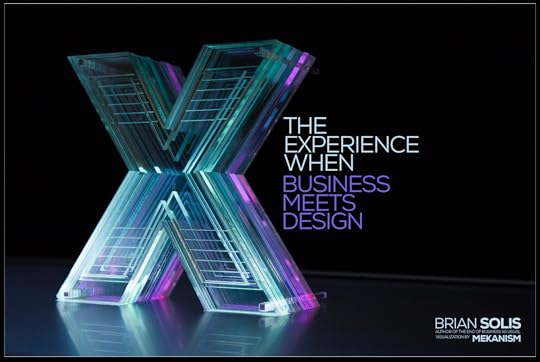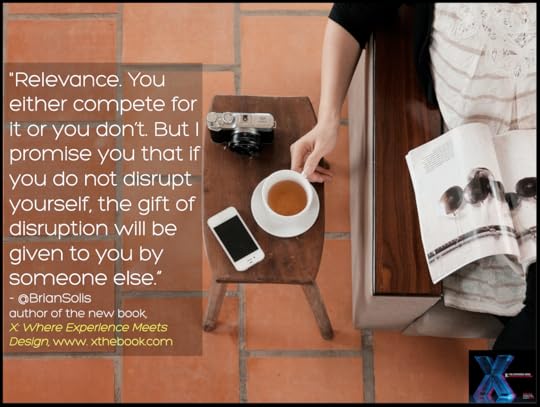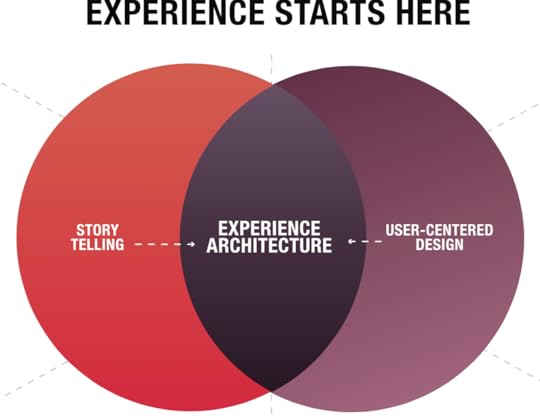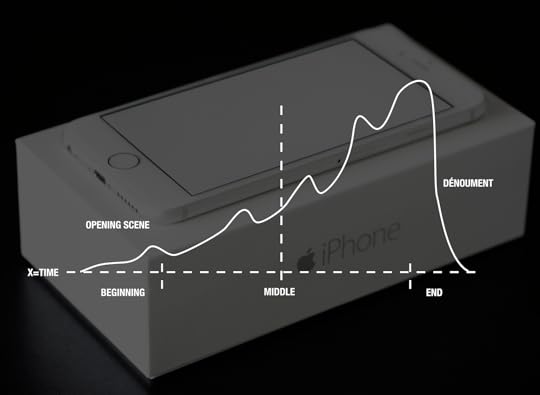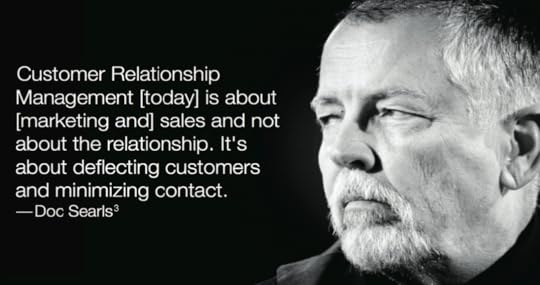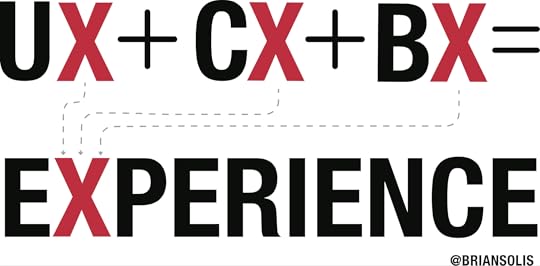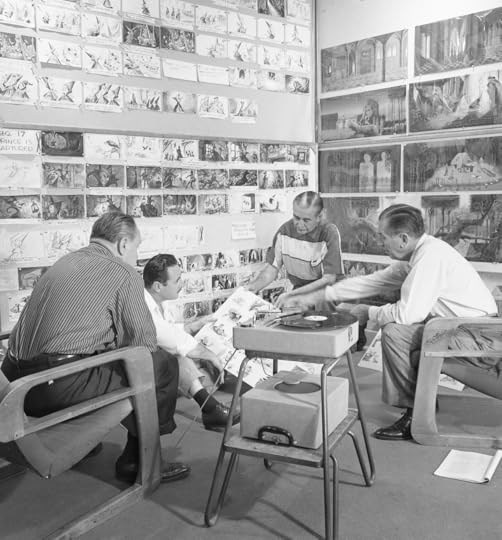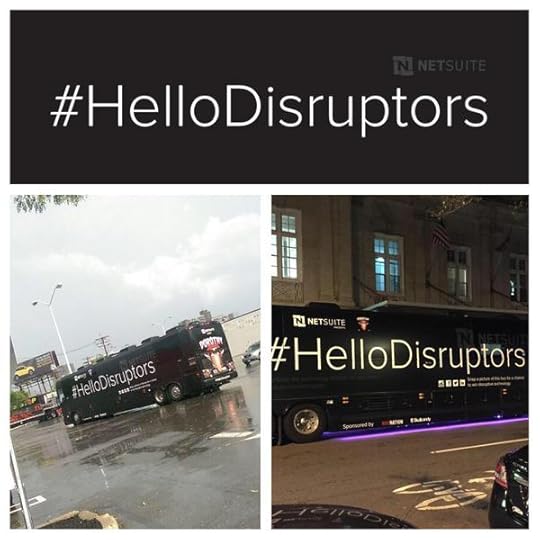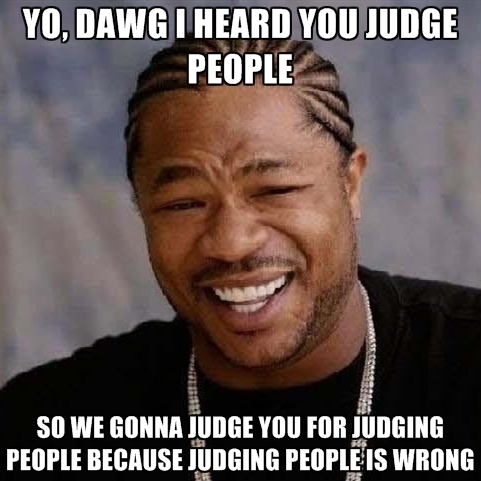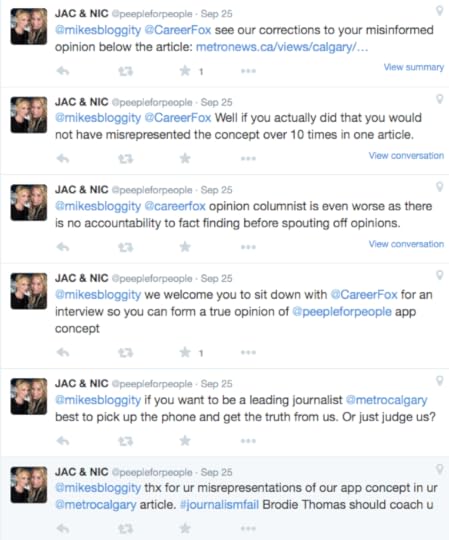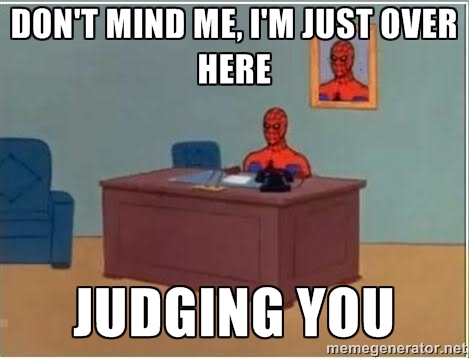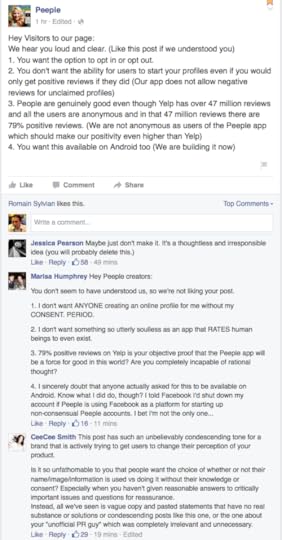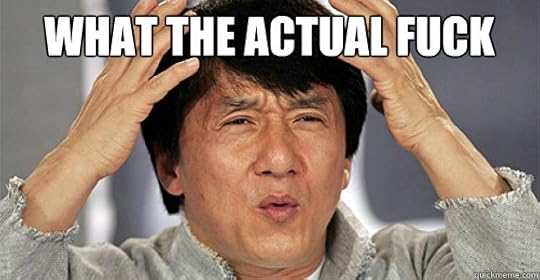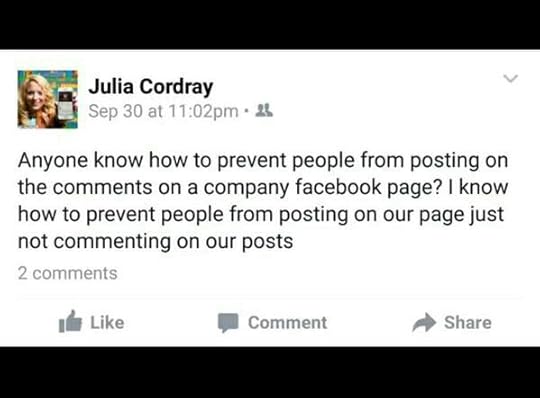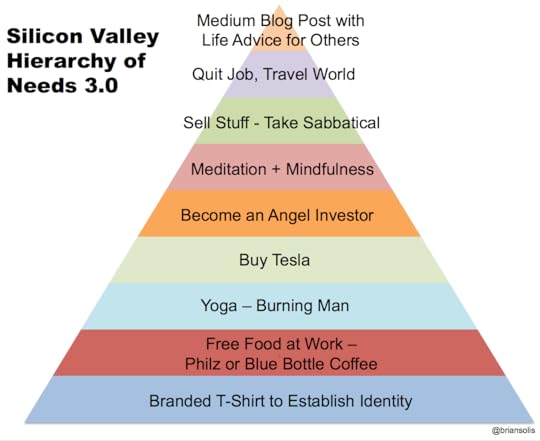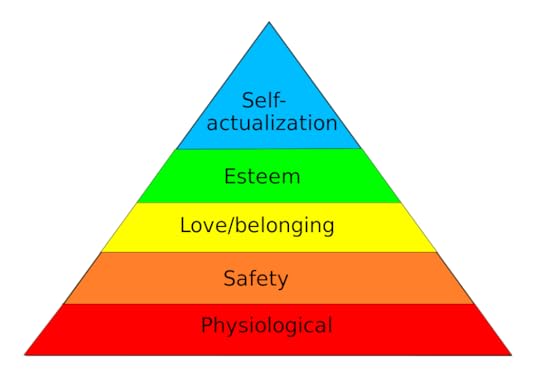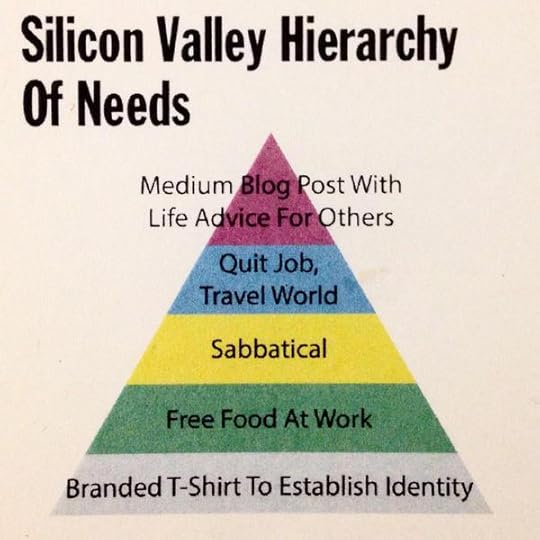Brian Solis's Blog, page 97
October 19, 2015
How To Unify Your Sales, Service and Marketing Departments Around Customer Experience
Guest post by Omar Akhtar (@obakhtar), Managing Editor, Altimeter Group, a Prophet company
Imagine you’re getting ready to drive your car. But when you turn on the engine, you get a mobile notification telling you that your oil needs to be changed, and it gives you a link to the nearest dealership with a 10% discount coupon. You’re left surprised and delighted by the sheer, almost magical convenience of it all. But is that event classified as a sales, service or marketing interaction? The correct answer is: all of the above.
Marketing is often regarded as the de facto custodian of the customer experience, especially when it comes to digital engagement. Hence it makes sense for it to have the best, most advanced tools for providing the delivering the optimal experience. But in today’s world of always connected, always on experiences, customer experience management is no longer just the responsibility of marketing, or even sales or service. Today, the entire company is responsible for the customer experience. And hence, the technology for customer experience management must allow multiple teams within a company to operate it in a unified, way delivering a seamless customer experience across all touchpoints.
For companies that have been moving towards the idea of unified “marketing cloud” or an integrated system of tools to operate all marketing channels, we’re saying, think bigger. To truly recognize the customer across each touchpoint, and provide a seamless experience at every interaction, the technology strategy must evolve from “marketing cloud” to the “customer experience cloud.”
Of course, that’s no easy task. Raise your hand if you’re tired of being told to “break down silos” but you don’t know where to start. Raise your hand if you want to build a great customer experience but you can’t define what that is. And raise your hand if you’re in charge of buying marketing technology but are overwhelmed by the thousands of software options that are available to you.
A new report from Altimeter, authored by myself and Charlene Li, titled: “The Customer Experience Cloud: How To Unify The Organization Around A Seamless Customer Experience” is written for anyone who identifies their organization as having these problems. The new reality of commerce is that brands are expected to be present on an ever-increasing number of channels, both online and offline. And customers expect to be recognized as the same unique individual across all of these channels. They want personalized content, real-time engagement, recognition across devices and serendipitous discovery all at once. This requires a major upheaval not just in the technology being used, but the organization of the company as well.
In this report, we’ve provided the essential technological and organizational components that companies need to unify the efforts of sales, service and marketing around building a seamless, cross-channel customer experience. Based on research interviews with leading brands such as Nike, McDonalds, General Motors and General Electric, we’ve found the common best practices for companies working towards this goal. And finally, we’ve created a starting guide for companies on choosing the right technology to support their unified customer experience plan, with an overview of the leading technology vendors that can help deliver on this vision.
Putting the customer experience cloud into practice is a major effort that will mean reorganizing teams, setting new governance, buying new technology and establishing new processes. It is nothing short of a comprehensive digital transformation. With so many parts of the puzzle required to fall in place simultaneously before any real execution, the most daunting part is knowing where to start. And with this report, we believe we can give companies that crucial starting point for how to adapt, and thrive in the face of what we think will be a major disruption in the way customers interact with brands in the digital age.
Omar Akhtar is the Managing Editor for the research team at Altimeter, A Prophet Company where he oversees the editorial process behind all of Altimeter’s publications, including its research reports, daily blog and multimedia content. In addition, he conducts and publishes research in the area of marketing/ customer experience technology

October 15, 2015
Wolfpack App is a Mobile Social Nichework for Guys to be Guys – Is this the Dawn of Social Nicheworks?
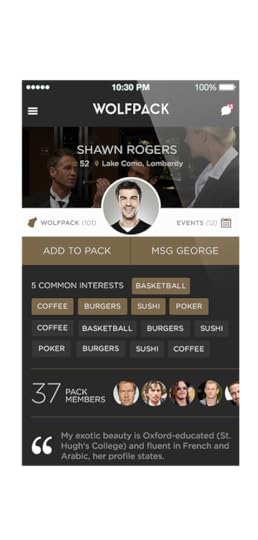 I thought I’d seen it all. Wolfpack app is a new mobile-centered, social network that helps guys connect with like-minded buddies around interests and events. When the news of Wolfpack’s debut landed in my inbox, I initially disregarded it as yet another “bro” app. I live in Silicon Valley where bro culture is a widely recognized problem. Too many of these bros after all are blamed for the lack of diversity and respect in startups among many other things that we can discuss later. But this isn’t yet another bro app by bros I quickly realized. It’s all about the bromance and quite honestly, real world friendships. Imagine that?
I thought I’d seen it all. Wolfpack app is a new mobile-centered, social network that helps guys connect with like-minded buddies around interests and events. When the news of Wolfpack’s debut landed in my inbox, I initially disregarded it as yet another “bro” app. I live in Silicon Valley where bro culture is a widely recognized problem. Too many of these bros after all are blamed for the lack of diversity and respect in startups among many other things that we can discuss later. But this isn’t yet another bro app by bros I quickly realized. It’s all about the bromance and quite honestly, real world friendships. Imagine that?
Nile Niami, a movie producer turned app developer, was inspired to create Wolfpack by a friend who was recently divorced. According to Niami, his friend was married for 20 years and lost track of all his old school friends. But what really struck me about the app was the tech, what it could ultimately mean, and also the ability for the app, though invisible to the user, to align geo-location, mobile, moments and interest graphs to build a series of hyper-localized nicheworks aka social networks based on interests in real-time. I realize this paragraph is full of buzzwords. Said another way, Wolfpack works like Foursquare for friendships and occasions.
Once the app is installed, Wolfpack asks users to select interests and hobbies. Then based on location, the app suggests upcoming events or offers the ability for users to create their own. At first pass, for example, I found several relevant bar nights, game days, softball and basketball pickups, and yes, even movie nights. The app also does its thing to connect me to potential friends and also upcoming events.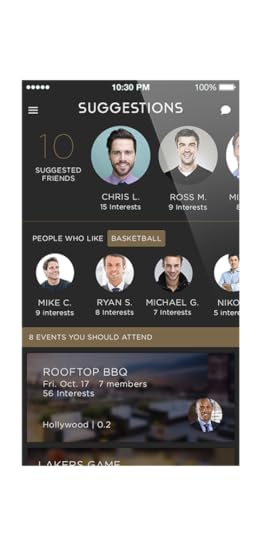
I travel pretty much all the time. And when I’m home, I’m usually working on my next research or book project. Something like this makes sense when I want to catch a San Francisco Giants or 49ers game, local music or a concert by my favorite and secretly favorite artists. Even though I have local friends, they’re not always available. And, they’re definitely not hanging out wherever I may be traveling. Furthermore, there are some things I like to do things locally that my best friends would rather not, although they sometimes indulge me, such as riding motorcycles, driving old cars and pursuing the Bay Area’s best cheeseburger.
While there are several existing networks and apps, the promise of Wolfpack is that it facilitates momentary friendships that offer realistic shots at longer-term friendships.
Though focused on dudes, the platform could be re-purposed for any interest-based nichework. And, this is what really interests me.
Path, founded by Dave Morin, once tried to limit connections to Dunbar’s famously misinterpreted number of 150 friends rather than Facebook’s cap of 5,000. Although it limited the number of ties, Path still focused on the social graph rather than true interest graphs. Wolfpack though represents a new genre of hyper-focused apps that attempt to put the social back in social networking—at least in the real world anyway. I honestly hope to see, and use, more apps connect us with people who can enhance our real world relationships even if it’s through digital means.
Connect with me… Twitter | LinkedIn | Facebook | Youtube | Instagram | Pinterest

Wolfpack is a Mobile Social Nichework for Guys to be Guys – Is this the Dawn of Social Nicheworks?
 I thought I’d seen it all. Wolfpack is a new mobile-centered, social network that helps guys connect with like-minded buddies around interests and events. When the news of Wolfpack’s debut landed in my inbox, I initially disregarded it as yet another “bro” app. I live in Silicon Valley where bro culture is a widely recognized problem. Too many of these bros after all are blamed for the lack of diversity and respect in startups among many other things that we can discuss later. But this isn’t yet another bro app by bros I quickly realized. It’s all about the bromance and quite honestly, real world friendships. Imagine that?
I thought I’d seen it all. Wolfpack is a new mobile-centered, social network that helps guys connect with like-minded buddies around interests and events. When the news of Wolfpack’s debut landed in my inbox, I initially disregarded it as yet another “bro” app. I live in Silicon Valley where bro culture is a widely recognized problem. Too many of these bros after all are blamed for the lack of diversity and respect in startups among many other things that we can discuss later. But this isn’t yet another bro app by bros I quickly realized. It’s all about the bromance and quite honestly, real world friendships. Imagine that?
Nile Niami, a movie producer turned app developer, was inspired to create Wolfpack by a friend who was recently divorced. According to Niami, his friend was married for 20 years and lost track of all his old school friends. But what really struck me about the app was the tech, what it could ultimately mean, and also the ability for the app, though invisible to the user, to align geo-location, mobile, moments and interest graphs to build a series of hyper-localized nicheworks aka social networks based on interests in real-time. I realize this paragraph is full of buzzwords. Said another way, Wolfpack works like Foursquare for friendships and occasions.
Once the app is installed, Wolfpack asks users to select interests and hobbies. Then based on location, the app suggests upcoming events or offers the ability for users to create their own. At first pass, for example, I found several relevant bar nights, game days, softball and basketball pickups, and yes, even movie nights. The app also does its thing to connect me to potential friends and also upcoming events.
I travel pretty much all the time. And when I’m home, I’m usually working on my next research or book project. Something like this makes sense when I want to catch a San Francisco Giants or 49ers game, local music or a concert by my favorite and secretly favorite artists. Even though I have local friends, they’re not always available. And, they’re definitely not hanging out wherever I may be traveling. Furthermore, there are some things I like to do things locally that my best friends would rather not, although they sometimes indulge me, such as riding motorcycles, driving old cars and pursuing the Bay Area’s best cheeseburger.
While there are several existing networks and apps, the promise of Wolfpack is that it facilitates momentary friendships that offer realistic shots at longer-term friendships.
Though focused on dudes, the platform could be re-purposed for any interest-based nichework. And, this is what really interests me.
Path, founded by Dave Morin, once tried to limit connections to Dunbar’s famously misinterpreted number of 150 friends rather than Facebook’s cap of 5,000. Although it limited the number of ties, Path still focused on the social graph rather than true interest graphs. Wolfpack though represents a new genre of hyper-focused apps that attempt to put the social back in social networking—at least in the real world anyway. I honestly hope to see, and use, more apps connect us with people who can enhance our real world relationships even if it’s through digital means.
Connect with me… Twitter | LinkedIn | Facebook | Youtube | Instagram | Pinterest

October 12, 2015
Experience is the Brand: Why this is the time for experience architecture
While I was in traveling in Europe, my friends at 800CEOREAD reached out to talk about X. I was so focused on production and printing that I’ve almost neglected letting people know that the book is finally getting released! I took the time to answer a handful of questions. But, I didn’t reply quickly. I took my time to share the depth of what X explores and how it will help you.
“Here’s the thing. Experience is the brand. Meaningful and shareable experiences are now forms of marketing.”
—Brian Solis
800-CEO-READ: You begin by telling us that marketing and advertising are generally prioritized ahead of investing in experience, yet it is a customer’s experience that leads to the most influential and effective advertising there is—word of mouth among customers. So, how do we go about changing that mindset, and redirecting resources accordingly?
Brian Solis: You’re exactly right and that’s where this story begins. Customer experience means just that. It’s the experience a customer has. What makes this so important is that in a connected economy, it’s also about the experience that people have and now share online. That moment stays on the internet. It doesn’t go away. And over time, shared experiences build upon one another forming a collective ensemble of people’s sentiment toward a company or product.
And here’s the thing. Experience is the brand. Meaningful and shareable experiences are now forms of marketing.
Today, companies react to experiences and try to shape them by marketing at people. As a result, experiences are unpredictable and left to chance. Why is that okay?
In X, which stands for “experience,” I introduce experience architecture over brand architecture so that companies can shape experiences by first designing them and bringing them to life in every aspect of the customer journey. Because that’s what customer experience is, the sum of each engagement a person has with a company, at every touchpoint, throughout the customer lifecycle. More importantly, customer experience is a series of emotions that marketing can’t shape, nor should it, in the long term.
Experience architecture becomes the new brand style guide to inspire and govern the entire journey… starting with company values, vision, and product and support design
800-CEO-READ: On the other hand, you share the story of a great Coca-Cola campaign—in which drones delivered cokes to migrant workers building the skyscrapers of Singapore—as a great example of a brand delivering an experience, or perhaps an experience delivering a brand. But, in this case it was surely a marketing team that came up with the “happiness” slogan, pinpointed the optimal time and most refreshing time for a Coke (during a work break at a physically demanding job), designed the ad campaign, made the savvy decision to work with the Singapore Kindness Movement to deliver thank you messages from Singaporeans on the ground along with the Cokes, and captured it all on film. This seems like an example of an ad campaign (as is the Nike soccer ad you reference soon after) delivering the experience—even if it isn’t a traditional campaign. Where is the overlap of advertising and experience architecture occurring right now? Is the line being erased? Should it be?
Brian Solis: These are indeed examples of “experiences as marketing” and marketing of experiences. The difference is important. The book covers the entire journey and in this particular section, I intended to introduce the idea that experiences as marketing work when the brand stands for something. It’s one of the reasons why I share Coca-Cola’s mission statement. These examples bring to life the experience the brand states it will deliver. And it attempts to do so beyond marketing but also throughout the customer journey.
However, I share stories throughout the book that capture best-in-class experiences in each moment of truth. The only company I discuss about being methodical about experience architecture at every step is Apple, chapter 8.1. There I detail every step of the iPad journey. The chapter was so detailed that it was a small book by itself. I think we cut 4,000 words from that section alone. It really is quite remarkable to what extent Apple thinks through the entire experience. They’ve literally designed it. And, I guess that’s the point. The importance of design is elevated to the executive level. Sir Jony Ive is much more than the company’s chief design officer, he’s also its chief experience architect.
800-CEO-READ: I’ve mentioned the Coca-Cola ad, and Apple is featured throughout the book (including the full treatment you discuss above) as a company that exemplifies delivering great, seamless customer experience. And they both do deliver great experiences—so great that both are widely recognized as addictive experiences, and not necessarily healthy at the levels we’re using them. Is there any onus on companies to craft experiences that not only benefit their bottom line, but also take into account the effects of that prolonged experience on the health of their consumers?
Brian Solis: I share many stats in the book to help offer new perspective and also create a sense of urgency. In one stat I share that customers are willing to pay as much as 25% more for a product they believe they will have a great experience with it. Imagine if a company invested in experiences throughout the lifecycle. Not only is profitability on the table but customer retention also increases. Great experiences deliver great ROI. So, yes, the onus is on companies to invest in experience and new models to support them, to cultivate long-term, lucrative relationships that are also mutually beneficial.
The key word here is relevance. You either compete for it or you don’t. But I promise you that if you do not disrupt yourself, the gift of disruption will be given to you by someone else. There is a disruption event on the horizon of every business and it’s just a matter of time for everyone.
Oh, and stop looking at your competition to see what they’re doing. Start looking at other industries that are delivering on amazing experiences and apply it to your work. Anything less is just an excuse.
800-CEO-READ: You mention that if we are going to focus on specific technologies, it should not be social media technologies but those we implement internally and in our front-line customer interactions, and that we must be deliberate about that process instead of implementing the latest “shiny object” technologies, platforms, or devices. What advice can you give in this regard?
Brian Solis: Customer experiences are broken because the customer engagement model is broken. Today, CX (customer experience) is governed by each different group that’s responsible for their portion of the purchase funnel. They use different technologies, are managed by different and sometimes competing metrics, are striving to achieve varying forms of reach and engagement that may or may not complement one another. Said another way, brands are made, and not cultivated through experience or relationships for the most part. Technology is often a crutch or a band-aid rather than an enabler of a vision for customer experiences.
For the most part, strategists still over-rely on broadcast approaches to talking at markets and audiences, use technology to scale and pursue efficiency at the cost of intimacy.
We can’t think technology first. I call that mediumism in the book. We have to think of people and experiences first. Then technology brings to life, in meaningful ways, experience architecture as designed and as optimized for each platform.
800-CEO-READ: You tell us that the borders between brand experience, user experience, and customer experience are crumbling, and that these fields are largely becoming one connected discipline. How is that happening, and how does a “data artist” support all of this? Following that line of thought… this reminds me a bit of the blurring of boundaries between anthropology and sociology. And, in fact, you describe how many companies are now hiring anthropologists to help study human behavior and improve their user experience. That’s fascinating to me. Oddly, it seems like most people agree that, as technology advances, considering human relationships and human nature matter even more. Do you think this will become the norm in companies across the board?
Brian Solis: Well, to be clear, I say that CX + UX + BX = X (Customer experience + user experience + brand experience = Experience). It’s a simplified formula to say that we should all work toward experience and that the principles and ambitions of each should ratchet up the organization under one, common, executive order. Experience and thus brand and customer relationships is the culmination of technology + humanities. I go into great detail about the advantages of each discipline and how each (and more) can and should work together.
One of the problems is that many executives are blind to the very people they need to thrive. They don’t live their brands the way customers do. So the idea of social science, including anthropology, ethnography, psychology, et al. offers a human-centered perspective that then serves as the essence of empathy and ultimately as the mission and purpose of a brand and the experiences it wishes to bring to life. A data artist as I introduce is not the data scientist that “Moneyball” fanatics are investing in as big data becomes bigger. Instead, it’s a role that looks at small data and applies human filters to ask different questions, which begets different answers.
800-CEO-READ: How does storytelling tie into all of this, and how can we tell a story through an experience—throughout time, in real time, and in real life? How does that change the stories we tell?
Brian Solis: I explore the different approaches to mapping customer journeys including traditional journey maps, experience maps, and experience flows. I also take a step back to learn about storyboards, specifically Disney’s and Pixar’s approach to them. I initially thought that storyboards were a form of illustrating an animated movie to save money on costly edits prior to production. That’s only partially true.
After spending time with former Pixar artist Nicholas Sung, I learned that storyboarding is the most important part of every story ever produced. It forces artists and storytellers to think through the story arc, characters, moments, to make each believable, engaging, entertaining, and more personal.
Storyboards are so critical to experience architecture that I dedicated an entire chapter to the subject. The process, as you see, forces brands out of the rut of creating brand-centric stories from a creative perspective and instead start from a position of empathy. The resulting stories are not only different, they’re meaningful and believable. In the book, I talk about AirBNB’s “Project Snow White” and how the company worked with Sung to rethink (and better understand) the renter and owner journeys. They learned so much more than they imagined. It completely changed the company’s approach in every moment of truth because they understood all of the dimensions affecting it before, during and after each stay.
“One of the problems is that many executives are blind to the very people they need to thrive. They don’t live their brands the way customers do. So the idea of social science, including anthropology, ethnography, psychology, et al. offers a human-centered perspective that then serves as the essence of empathy and ultimately as the mission and purpose of a brand and the experiences it wishes to bring to life.”

October 6, 2015
Marketing to Marketing to Reimagine Marketing
Guest post by Fred Studer (@fredstuder), Chief Marketing Officer at NetSuite
Sometimes, in fact oftentimes, the most important audience for your message are the people who are already working for you.
In an age of online surveys and instant feedback across social channels, articulating your message to the people who work in your company can often be neglected. In fact, if you haven’t convinced and energized your own people, you’re going to be hard pressed to convince the market.
My early marketing days were working with Larry Ellison at Oracle and one of his key philosophies was that marketing wasn’t just for people outside the company but rather for our teams within the company so that they understand what we are selling, how to discuss it and differentiate it. That goes for the marketing team as well.
Marketing is about asking people to believe what we’re saying at scale. We need to be convinced enough about what we do in order to tell them why we’re so great. The most powerful method is by having everyone authentically understand and believe in the brand promise. Then you no longer have to market, you get a chance to create a movement through your best advocates, your employees.
Take our recent NetSuite campaign #HelloDisruptors for example. The campaign features NetSuite customers who are disrupting their industry, businesses like Lyft, FitBit and Alton Lane. We’re integrating that with social media, and the really cool part, a rock ‘n’ roll tour bus. We’re working with Dorothy (@itsdorothysucka), one of the kick-ass guest bands from our SuiteWorld user conference in May, outfitting their tour bus, encouraging people to take pictures of the bus and asking them to post those images to social media for a chance to win giveaways from our awesome customers disrupting their industry.
It got us a three-way win. First, it showcased internally what fresh marketing looks like and some of the new things that we want to do here at NetSuite. Secondly, we wanted to make this about real customers, not just logo slathering, but something authentic and exciting. And nothing is more exciting than a rock ‘n’ roll around the city and cool prizes. That gives people a chance to take a second look at NetSuite and say, “maybe I don’t know them as well as I thought.”
Third, we hit one of our core tenants of storytelling. Humans want to tell stories. We are creatures that like to do things around social needs. We started sitting around campfires cooking food, telling stories, then we started the art of music.
And that’s a key point here. You can’t assume your internal audiences will understand your message. Many will without any prodding but getting everyone on the same page and motivated is paramount.
Let’s face it, much of NetSuite’s history is focused around accounting software. Not necessarily an obviously sexy topic, but as it turns out it is VERY sexy. We’re the platform of choice for some very cool, very disruptive businesses. The chance to highlight these disruptive companies, along with some disruptive voices in the market was a great way for our team to puff their chest up a little bit.
If your own team isn’t excited and proud, it’s hard to expect the same from your customers. And, as I’ve said in this space before, if we make a difference for our customers, they, in turn, will market us to their own customers. Then marketing becomes more focused on community building and helping to inspire members of that community to engage with their peers.
Being able to activate that army of people with that passion of conviction, that is when you get this epic wave – it becomes an obligation, not just an opportunity.
Yes, establishing that conviction can be a challenge. It’s a process, much like a habit. Habits aren’t just hard to kick, they’re hard to establish. No one says, “I can’t wait to start flossing.” Establishing a habit of conviction in your company, your product, your movement demands positive reinforcement. We’re reinforcing the great stories of our customers with #HelloDisruptors.

October 1, 2015
The New Peeple App Does Not Represent People; Stop This App Before It’s Released
“Character is destiny.” This is the ironic tagline for Peeple (I’m not linking to it), a new app that wants to be the “Yelp for people” allowing anyone to rate you “professionally, personally and romantically” as long as they have 1) a Facebook account, 2) your phone number and 3) that they’re a real person.
I’m not kidding. This is a real app that is one-to-two months away from impacting your social, professional and dating graphs all because two enterprising entrepreneurs are confusing capitalism and privatism. Even as I write this, I can’t help but wonder if we’re all being trolled. The concept is just that absurd. It’s almost unbelievable that this is just another attempt at ranking people with each failing due to public backlash. The problem here is part entrepreneurial shortsightedness and also the shameless investors who pour money into these ventures.
There’s already a Change.org petition to stop the release of the app.
So, if character is destiny, it is certainly rooted in legacy. Borrowing from John Wooden, “character is about who you are when no one is watching.” And, we don’t need an app for character let alone who and how we are as friends, colleagues and lovers.
Yelp for restaurants is not at all the same thing as Yelp for humans. The fact that this needs explaining demonstrates the gall or the ignorance or the lack of basic human understanding (or all of the above) that co-founders Julia Cordray and Nicole McCullough appear so intent on avoiding.
In an interview with Caitlin Dewey of The Washington Post, Cordray justified the app this way, “People do so much research when they buy a car or make those kinds of decisions, why not do the same kind of research on other aspects of your life?”
Nope. It’s not even close to being the same. Not at all. We really don’t need or want an app for that.
If you want to rate someone professionally, well, go to Yelp or any number of online business-focused apps and communities. If you want to rate someone romantically, swipe left or use a dedicated dating app with an integrated review system. Even Lulu was chastised for its approach to radical transparency when it allowed women to rate only men. If you want to rate or explore reviews to understand the character or reputation of another human being AS A person, then consider how you got to that very moment and start to rethink your life goals and choices.
Everything about this app is wrong. According to the Washington Post, the app was originally supposed to scrape names automatically from Facebook, but the site’s API wouldn’t allow it — to Cordray’s visible annoyance (the video has since been removed of course). Could you imagine if the founders got their way even if for a moment before it was stopped?
“All human beings have three lives: public, private, and secret.”― Gabriel García Márquez
Blurring professional, personal and romantic reviews for anyone to see is preposterous, even if it’s comprised of only glowing reviews. The lack of context and more so consent is senseless and more so irresponsible. Having a human “score” is far worse than having an attempt at it. I’m not sure if McCullough and Cordray are simply headstrong, ignorant or oblivious to social norms and ethics but judging by how they’re reacting to the public’s reaction, there is certainly a combination of all of the above.
Even as critics provide constructive and also destructive feedback, the team does not seem to grasp why people are lashing out with such avidity. Mike Morrison writing for the Calgary Metro News published his thoughts on the app and was basically harassed by McCullough and Cordray publicly…how ironic.
The duo even tried to appeal for emotional support by publishing a quote by Theodore Roosevelt, “It’s not the critic who counts; the credit belongs to the man who is actually in the arena.”
It’s a beautiful quote. But there’s a difference between trying to do what’s right and simply trying to do something just because, well, you… The replies are priceless and symbolic. But what’s troubling is that the founders are insistent on not actually listening to the very people they’re hoping to spotlight with their app. Try considering each response “a review” of your review app…an overwhelming opposition is taking shape across the entire web.
“As two empathetic, female entrepreneurs in the tech space, we want to spread love and positivity,” Cordray stressed to the Washington Post. “We want to operate with thoughtfulness.”
If that’s true then perhaps these founders should listen as much as they’re talking…or should I say promoting. They’re currently on a media blitz raising awareness for the app. And with every new story they sell, the greater the waves of logic and humanity that crash upon them.
Here’s a short list of organized feedback for starters…
– No consent.
– Bias.
– Zero path to accuracy.
– Invasiveness.
– The objectifying of people.
– Belittling reputation with unscientific and even harmful algorithms.
– Absence of context
Rather than use these reviews to inform their decisions, like you know, the way a review app would work, McCullough and Cordray are further validated in their mission to dehumanize human character by talking around or down to its critics across the Web. This would be a good time to take a step back and rethink the purpose and approach overall. Instead, they lean on the private emails they receive as justification for their premise—even if that feedback eerily demonstrates the dangerous butterfly effect this app may wield.
Here’s one such example…
Comments by people who email us:
“Great idea! I work in the cryptocurrency space, and we have a huge need for this sort of information. Do you plan to open up an API for querying? Could we, for instance, display a person’s reputation information in one of our apps, to give our user extra info before sending payment? I’d be very interested in hearing more, and/or beta testing! ”
Ira M. thanks for your question. We have had a lot of API requests to help companies and organizations make better decisions with online purchasing such as yours. We will consider it in the future and will have a licensing agreement available to companies that want to do just that. Keep in mind that only the professional side of the app will be available for purposes such as your request.
The response is exactly how a normal person would react…
Wow. So you want to have an app that allows others to publicly judge the character of people that use it, and then allow third party companies to mine that information?
The entire thing is so strange that a parody account already exists on Twitter. For further evidence of this, just hope over to Peeple’s Facebook page for an immersion in how not to engage communities.
If that isn’t enough, read this incredibly perverted twist on feedback masquerading as courage published by Peep’s founders…better yet, read it in line with colorful commentary by analyst/author and good friend Josh Bernoff. In this strange “Ode to [Delusional] Courage,” McCullough and Cordray refer to themselves as “unapologetic, bold innovators.”
WTAF. Seriously.
Discovering human qualities is supposed to be part of life. And how you and I live our lives, for the most part, is not expected to be gamified and recorded at every step let alone partially reassembled through random dealings and unsystematic, and imperfect reviews of those that get around to publishing them.
As “Anthony B” so astutely points out on Twitter, how can Peeple stand for the right things if its founders don’t even want or like unsolicited feedback.
Brilliant indeed.
The people of the Internet have spoken and they choose not to be Peeple. Character is indeed destiny. It’s human. It’s imperfect.
To quote John Wooden once again, “Be more concerned with your character than your reputation, because your character is what you really are, while your reputation is merely what others think you are.”
UPDATE: Peeple is listed on Yelp and the reviews are starting to pour it.
My next book is coming out soon, X: Where Business Meets Design
Connect with me… Twitter | LinkedIn | Facebook | Youtube | Instagram | Pinterest

September 28, 2015
Silicon Valley Hierarchy of Needs
The other day, my friend Loic Le Meur shared a hilarious take on Maslov’s famous Hierarchy of Needs, simply called, “Silicon Valley Hierarchy of Needs.” For many, including me, the list of laughably superficial “needs” of those mocked in Silicon Valley are also a little too familiar or relatable. We all know that person, someone like them, or we’ve seen them characterized in spoofs, TV, movies, books, etc.
As a refresher, Abraham Maslov’s Hierarchy of Needs were inspired by his work seeking to understand what motivates people. He believed that a set of motivation systems are inherent in all of us unrelated to rewards or unconscious desires. As we achieve one need, we seek to fulfill the next one and the next one.
The most widespread, and earliest version of Maslow’s Hierarchy of Needs features five motivational needs stacked as levels.
The model, most often depicted as a pyramid, includes the following needs (starting from the bottom):
1. Biological and Physiological needs – air, food, drink, shelter, warmth, sex, sleep.
2. Safety needs – protection from elements, security, order, law, stability, freedom from fear.
3. Love and belongingness needs – friendship, intimacy, affection and love, – from work group, family, friends, romantic relationships.
4. Esteem needs – achievement, mastery, independence, status, dominance, prestige, self-respect, respect from others.
5. Self-Actualization needs – realizing personal potential, self-fulfillment, seeking personal growth and peak experiences.
Silicon Valley Hierarchy of Needs
The original Silicon Valley Hierarchy of Needs was meant to poke fun at an often indifferent or isolated ecosystem of entrepreneurs, investors, mentors, marketers lawyers and everyone in between. It hits home. By the way, I tried to find the source to properly credit the original parody. If you can help, please share in the comments and I’ll update accordingly.
Silicon Valley is in fact home for me and I have lived through all of the trends both good and bad going back to the pre-Internet Gold Rush. At the same time, over the years, I’ve often taken a a outsider’s perspective to appreciate the evolution of tech culture in the Valley and around the world. This particular interpretation, while intentionally simple, strikes a chord with people who can relate one way or another. It’s funny, poignant and an incredible conversation starter.
Inspiration consumed me and I immediately began work on version 2.0. Upon release, the feedback was instantaneously returned. So much so, that I had to immediately develop version 2.1. While the conversations were lighthearted and mostly filled with hysterics, truisms and denials, there was also a substantial volume of logic that shaped version 3.0 (featured).
“This should go before that.”
“What about this…?”
“You’re missing that…”
“It’s Prius not Tesla…”
“Where’s Bulletproof Coffee.”
Trust me, there are so many stages on the cutting room floor.
Version 3.o clearly sparked a fantastic conversation that serves as a satire of a very important geographical location and historic innovation movement. It’s not accurate nor is it intended to be. But please do keep the comments coming. In the mean time, have fun with it. Laugh. By all means however, grow and keep pushing forward
p.s. to all of my friends who find themselves on this list, I admire you!
My next book is coming out soon, X: Where Business Meets Design
Connect with me… Twitter | LinkedIn | Facebook | Youtube | Instagram | Pinterest

September 24, 2015
Announcing My Next Book: X, The Experience When Business Meets Design
It is with great pride, relief ,mixed with a bursting sensation of anxiousness, that I announce my next book, X: The Experience When Business Meets Design.
It’s been a long road to get here. I started writing this book 3.5 – 4 years ago. I couldn’t get my mind fully around the subject matter and instead fully embraced my avoidance behavior syndrome and ended up writing a book that wasn’t in my plan at all, What’s the Future of Business (WTF) – Changing the Way Businesses Create Experiences. In hindsight, it was meant to be as WTF served as both a mental and physical bridge to X. Now 2.5 years since the release of my last book, X is set to hit shelves and screens mid-October.
It is available for pre-order today and it would mean everything if you could help support me in this new endeavor. #thankyou
800CEOREAD | Amazon | Barnes and Noble | BAM |
X = Experience
Welcome to a new era of business in which your brand is defined by those who experience it.
Do you know how your customers experience your brand today?
Do you know how they really feel?
Do you know what they say when you re not around?
In an always-on world where everyone is connected to information and also one-another, customer experience is your brand. And, without defining experiences, brands become victim to whatever people feel and share.
X reveals why great products or service are no longer good enough to win with customers and why creative marketing and delightful customer service too are not enough to succeed. With each turn of the page, I share why the future of business is experiential and how to go about creating and cultivating meaningful experiences.
Design by Mekanism
The irony isn’t lost on me that this story about digital transformation is told in book form. But, this isn’t your ordinary business book.
The whole idea of what a book is and what it could be was completely re-imagined for a digital meets analog world. From the shape to its structure how the story unfolds is hyper-designed to be a relevant while aiming to evoke a sensational experience.
Over the last couple of years, Mekanism and I worked together as if we were designing a mobile app. In fact, our working premise was how to make print feel as intuitive as anything you do in your smartphone or tablet. And more so, how do we make paper relevant in a digital economy.
It’s beautiful and functional. It’s design as an art to meet objectives. All the while, the book is meant to evoke emotion and also offer new perspective and insights to help you win the hearts and minds of your customers. More so, the design of this book, along with what fills its pages, was done using the principles shared within.
The book is the experience.
Thank you for your support over the years. I’m very privileged to have you with me on this journey. I hope you love this book. I was inspired by what’s possible when you get your hands on it and start to bring to life new ideas that do nothing less than change everything.
Video by Mekanism

It’s Official – Announcing My Next Book: X, The Experience When Business Meets Design
It is with great pride, relief ,mixed with a bursting sensation of anxiousness, that I announce my next book, X: The Experience When Business Meets Design.
It’s been a long road to get here. I started writing this book 3.5 – 4 years ago. I couldn’t get my mind fully around the subject matter and instead fully embraced my avoidance behavior syndrome and ended up writing a book that wasn’t in my plan at all, What’s the Future of Business (WTF) – Changing the Way Businesses Create Experiences. In hindsight, it was meant to be as WTF served as both a mental and physical bridge to X. Now 2.5 years since the release of my last book, X is set to hit shelves and screens mid-October.
It is available for pre-order today and it would mean everything if you could help support me in this new endeavor. #thankyou
800CEOREAD | Amazon | Barnes and Noble | BAM |
X = Experience
Welcome to a new era of business in which your brand is defined by those who experience it.
Do you know how your customers experience your brand today?
Do you know how they really feel?
Do you know what they say when you re not around?
In an always-on world where everyone is connected to information and also one-another, customer experience is your brand. And, without defining experiences, brands become victim to whatever people feel and share.
X reveals why great products or service are no longer good enough to win with customers and why creative marketing and delightful customer service too are not enough to succeed. With each turn of the page, I share why the future of business is experiential and how to go about creating and cultivating meaningful experiences.
Design by Mekanism
The irony isn’t lost on me that this story about digital transformation is told in book form. But, this isn’t your ordinary business book.
The whole idea of what a book is and what it could be was completely re-imagined for a digital meets analog world. From the shape to its structure how the story unfolds is hyper-designed to be a relevant while aiming to evoke a sensational experience.
Over the last couple of years, Mekanism and I worked together as if we were designing a mobile app. In fact, our working premise was how to me make print feel as intuitive as anything you do in your smartphone or tablet. And more so, how do we make paper relevant in a digital economy.
It’s beautiful and functional. It’s design as an art to meet objectives. All the while, the book is meant to evoke emotion and also offer new perspective and insights to help you win the hearts and minds of your customers. More so, the design of this book, along with what fills its pages, was done using the principles shared within.
The book is the experience.
Thank you for your support over the years. I’m very privileged to have you with me on this journey. I hope you love this book. I was inspired by what’s possible when you get your hands on it and start to bring to life new ideas that do nothing less than change everything.
Video by Mekanism

September 21, 2015
Why Customer Experience is The Catalyst for Digital Transformation
As a digital analyst, I spend a lot of his time thinking about the future of customer experience. So much so that my next book attempts to rethink the term “experience,” X:The Experience of Business Meets Design. “X” explores experience architecture the various ways companies can design meaningful and shareable experiences in every moment of truth.
I recently spent time with the team at VisionCritical as part of the prep for its their upcoming conference in Chicago, 2015 Vision Critical Summit . My presentation is based on X and the conversation about what it should cover resulted into something that they felt worth sharing and I did too.
I hope it helps you. Please share your experiences in the comments…
Your book tackles the idea of experiential marketing. How is experiential marketing different from traditional marketing, and why should companies care about it?
X is about experiences and experiential architecture, and marketing is just one part of it. Customer experience is beyond just any one moment. It’s every moment plus all moments combined. You have a few great moments and some not-so-great moments. The problem with the approach to marketing today is each one of those moments is owned, managed and measured by different groups, and those groups don’t always collaborate. Nor are they working on a common vision of what those moments should be. They’re almost working to fail when you look at the experience collectively.
Looking at marketing as a slice of the experiential pie, traditional marketing is very ego-centric. Someone’s idea is executed by a team and then measured by how that idea performs. Ideas are ego-driven and are driven by campaigns, so they come and go. In contrast, an experience is something that doesn’t stop. Customer experience happens with or without direct interaction with marketing. If I use a product, look at your website or come across your campaign, these things happen without the company knowing my impressions, my expressions or what I say about them to others.
Experiential marketing is about starting with a vision, executing to get that vision, and then collaborating with the rest of the organization to ensure that it is met and delivered consistently. In a sense, experiential marketing pushes marketing to become bigger than its role today. It ensures that experience is kept on point and kept alive throughout the lifecycle.
In an interview with PSFK , you mentioned that brands often lack a holistic, 360-degree view of the customer. What are the challenges facing brands in terms of truly getting a more complete picture of their customers?
Some departments are now accelerating their efforts in customer research, data-driven marketing, customer service and loyalty (through their CRM system). The problem is that these efforts often lack integration with existing data. Many people in the organization have no way of getting data that’s already available.
Integrating customer data is important because it allows companies to take action. It’s what you do with data that really matters. It’s how you are inspired by data to improve your business.
Companies have net promoter scores to look at whether or not the customer is happy. We have surveys. We have customer support initiatives that will ask something like “did we answer all your questions today?” We have customer sentiment in terms of marketing response, impressions, clicks, views, etc. But all of these give us an incredibly limited view of the customer. We don’t really get an idea of who the customer is.
Some companies (especially those in marketing and customer experience design) are getting into persona development. They’re starting to humanize their customers. But there is no chief customer architect who’s asking, “What’s really important to our customers?” No one in the company is asking, “How do we bring all the insights we have and ensure that we’re delivering the things that will improve every customer touch point?”
From a product design and human-centered approach perspective, IDEO is a great example to follow. The company is rethinking how it conducts business with a single view of the customer and delivers against that standard. And IDEO shows that the key is not just about setting up data columns and creating personas. It’s about building an infrastructure to ensure that the customer journey is consistent. A true 360-degree view of customer is not just about omnichannel, data or CRM. It’s about people working together with a purpose.
You’ve spent a lot of time thinking about the future of customer experience. What are some of the traits of companies that get CX?
They are inspired by their customers. Everything they do is by and for their customers.
A common idea is that a great experience is something that happens only from a customer service perspective. A misconception is that customer experience is about having a wonderful shopping experience or having great sales professionals who help you find what you’re looking for.
That’s not an experience. In reality, experience is the sum of all touches throughout the customer relationship. The companies that understand this look at that philosophy and apply it across the board. They’re re-examining everything from their brand messaging to their products to their packaging and product design. They are trying to figure out, “How can we be more useful? What keeps our customers frustrated? And what are their aspirations?” These are foundations based on social science, being more human-centered with the aim of being more relevant and engaging. They reinvent the entire infrastructure of their organization to matter.
One of the best traits of organizations that are changing is that they take a step back and evaluate the customer experience, identify the frictions and imagine what could be. That last part, that’s the area for innovation right there. It’s not just about optimizing within; it’s also about looking at the future—at what could be.
You recently did a study with CapGemini Consulting about innovation centers and how big brands are using them. One of the key findings is that some industries (e.g. Telecom) have been laggards adopting innovation centers. What factors hold these industries back, and what can they do to catch up?
Innovation is based on a vision of what’s possible and the pursuit of what’s possible. Doing that takes leadership.
A lot of times, organizations are designed and managed from a “management” perspective. They develop processes, put them into place, and use that as a metric of success. A leadership organization is about what could you do better and what could you do differently. It’s informed not by bureaucratic processes or navel gazing, but driven by insights.
Remember that disruption comes from anywhere. Everyone looks at the number one or number two organization in their sector, but disruption is not just about your competitors. When you are too focused on your competitors, you ultimately get caught up in the game of irrelevance. When you only look at your competitors, what you see is the emergence of companies like Uber and Airbnb—disruptive startups that are human-centered for a different kind of a customer.
It’s not just about millennials and Gen Z either. It’s about how technology and lifestyle evolution are changing the behaviors and expectations of people. Innovative organizations recognize it’s just a matter of time before a well-funded startup competes against them. Startups have the advantage because they don’t have legacy and politics and other typical corporate challenges that stand in the way of seeing new possibilities.
Most companies have R&D facilities. But even those companies don’t facilitate innovation. Innovation comes from being inspired by your customers. It comes back to this mantra: Disrupt to be disrupted. It’s inevitable.
Technology is a sector that is inherently innovative, but it doesn’t really matter what industry you’re in and what type of business you’re in, whether it’s B2B or B2C or even government, medical or what have you. It really has more to do with the culture of the organization. That may sound abstract, but culture really is the most important thing in the organization. It’s also one of the most underrated competitive advantages any company could have. In leadership organizations, culture is the trait of innovation. There’s a feeling of empowerment and aspiration and challenge. Those traits are not industry specific; they’re human specific, and regardless of your industry or role, sometimes the best way to shift the company comes from the middle. Visionaries like Richard Branson and Howard Schultz are rare. Change happen because people in the organization believe that there’s a better way of doing things and bring disruption from the inside out.
You recently blogged about the six stages of digital transformation maturity . What role does customer engagement and listening have in this process?
Digital transformation is something that is enterprise-wide. In fact, it’s beyond the enterprise. It’s about the entire ecosystem of an organization, from supply chain, to retail, to sales channels. It’s about leveraging technology to improve or invent new models or processes for businesses in a digital time.
I focused my research on customer experience because digital transformation needs a catalyst. There’s no budget for “digital transformation.” It’s also not driven by the information technology organization. When we think about digital transformation, we really have to think about technology. How is your company leveraging new technology to drive innovation?
Digital technology is driven by the desire and need to uncover who your customers are and how they behave. Customer experience is often a catalyst because it represents a dollar sign in the organization.
The people thinking about digital transformation are thinking about ways of optimizing the customer journey. Even companies like Google are thinking about this topic. While Google makes its money through Search, it recently introduced what it calls “micro-moments” to help businesses understand that the customer is changing. The information customers are looking for and the devices they use are evolving, but most companies are still operating in a Web 1.0 world. One of the biggest opportunities is to rethink everything—just to step back and think, “hey, what’s the point of our website in the mobile world today, and how could we reinvent it to make it more useful and more meaningful to today’s customers?”
In the business world, you’re going to hear more about social sciences because when we’re talking about customer engagement, what we’re really talking about is anthropology and ethnography—looking at ways to understand the customer and identify archetypes for your ideal customer. Social sciences will help inspire companies to achieve different states of being, if you will.
When you engage with your customers, you can get insight, but what you do with that information is what drives change in the enterprise. It’s not about profit, it’s not about process improvement, technology to scale, or efficiencies. What we’re really looking at is customer-driven insight to find ways to disrupt yourself, not just in how you work but also in what’s possible. The idea of disruption because of customer insight and customer experience is looking at not just how you would improve customer experience, but how would you disrupt it? It’s about thinking and acting almost like a startup.
When it comes to customer engagement, the questions you ask inform the answers you get. Social science is going to be one of the biggest champions for driving evolution and revolution in business. It’s dependent on the person asking the question. If you have the same old questions, then you’ll get the same old answers. If you’re using the same processes and models, then we’re not going to move towards a new direction.
Connect with me… Twitter | LinkedIn | Facebook | Youtube | Instagram | Pinterest
X



